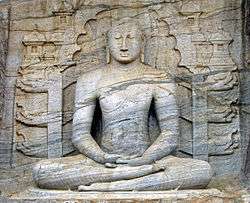Anupubbikathā
| Part of a series on |
| Theravāda Buddhism |
|---|
 |
In Theravada Buddhism, anupubbikathā or ānupubbikathā[1] (Pali) – variously translated as "gradual discourse,"[2] "gradual instruction,"[3] "progressive instruction,"[4] and "step-by-step talk"[5] – is a method by which the Buddha taught the Dhamma to suitably receptive lay people. In this approach, the Four Noble Truths are the consummate teaching. The common formula is:
- Generosity (dāna)
- Virtue (sīla)
- Heaven (sagga)
- Danger of sensual pleasure (kāmānaṃ ādīnava)[6]
- Renunciation (nekkhamma)
- The Four Noble Truths (cattāri ariya-saccāni)[7]
From the Pali Canon
In the Pali Canon, the title for this training, its general intent and outline are provided in the following narrative formula (in English and Pali) which is found in multiple discourses:[8]
|
"Then the Blessed One gave the householder ... progressive instruction, that is, talk on giving, talk on virtue, talk on the heavens; he explained the danger, degradation, and defilement in sensual pleasures and the blessing of renunciation. When he knew that the householder['s] ... mind was ready, receptive, free from hindrances, elated, and confident, he expounded to him the teaching special to the Buddhas: suffering, its origin, its cessation, and the path."[9] |
Atha kho bhagavā ... gahapatissa ānupubbīkathaṃ kathesi. Seyyathīdaṃ: dānakathaṃ, sīlakathaṃ, saggakathaṃ, kāmānaṃ ādīnavaṃ, okāraṃ saṅkilesaṃ, nekkhamme ānisaṃsaṃ pakāsesi. Yadā bhagavā aññāsi ... gahapatiṃ kallacittaṃ muducittaṃ vinīvaraṇacittaṃ udaggacittaṃ pasannacittaṃ, atha yā buddhānaṃ sāmukkaṃsikā dhammadesanā, taṃ pakāsesi: dukkhaṃ samudayaṃ nirodhaṃ maggaṃ.[10] |
Details for this training are provided in DN 2[11] and, to a lesser degree, in MN 27 and MN 51.[12]
See also
Notes
- ↑ For some alternate spellings of this Pali word, see Rhys Davids & Stede (1921-25), p. 39, entry for "Anupubbikathā," retrieved 2008-01-21 at http://dsal.uchicago.edu/cgi-bin/philologic/getobject.pl?c.0:1:1021.pali. Also note that, in the La Trobe University (n.d.) on-line edition of the Canon, the middle "i" of anupubbikathā or ānupubbikathā has a macron (ī).
- ↑ "Gradual discourse" is found, for instance, in Walshe (1995), p. 215.
- ↑ The translation "gradual instruction" is used, for instance, by Nyanatiloka (1980), entry for "ānupubbī-kathā" at http://www.budsas.org/ebud/bud-dict/dic3_a.htm.
- ↑ "Progressive instruction" is used, for instance, Ñāṇamoli & Bodhi (2001), p. 485.
- ↑ Thanissaro (1998).
- ↑ In regards to translating ādīnava, Bullitt uses the word "drawbacks" while Ñāṇamoli & Bodhi (2001) use "danger" (p. 485), and Rhys Davids & Stede (1921-25) recommend "disadvantage, danger" (p. 99, entry for "Ādīnava," retrieved 2007-11-13 from http://dsal.uchicago.edu/cgi-bin/philologic/getobject.pl?c.0:1:2695.pali).
- ↑ See, for instance, Bullitt (2005).
- ↑ According to Nyanatiloka (1980), three discourses that include this formula are DN 3, DN 14 and MN 56 (see Nyanatiloka, 1980, entry for "ānupubbī-kathā" at http://www.budsas.org/ebud/bud-dict/dic3_a.htm). A search of the on-line La Trobe University (n.d.) database reveals that the compound term ānupubbīkathaṃ (see http://www.chaf.lib.latrobe.edu.au/dcd/pitikaresults.php?title=&start=0&to=10&searchstring=ānupubbīkathaṃ Archived September 1, 2007, at the Wayback Machine.) can be found ten times in the Vinaya Pitaka and eight times in the Sutta Pitaka including: DN 3 (D.i.110), DN 5 (D.i.148), MN 56 (M.i.379), MN 91 (M.ii.145), AN 8.12 (A.iv.186, 8.1.2.2), AN 8.20 (A.iv.209, 8.1.3.1), AN 8.21 (A.iv.213, 8.1.3.2), and KN's Ud. 5.3 (Ud. 48) (see Thanissaro, 1998). Additionally, a search of the La Trobe University database for ānupubbiṃ kathaṃ (see http://www.chaf.lib.latrobe.edu.au/dcd/pitikaresults.php?title=&start=0&to=10&searchstring=ānupubbiṃ%20kathaṃ Archived September 1, 2007, at the Wayback Machine.) results in two instances of the formula being found in DN 14 (D.ii.41, D.ii.44). In DN 14, the identified formulaic statement is not stated by Gautama Buddha (who, according to the Pali canon, is the 28th Buddha) but by Buddha Vipassī (the 22nd Buddha), thus reinforcing that the Four Noble Truths are "the teaching special to the Buddhas," that is, Buddhas in addition to this age's self-awakened one, Gautama Buddha (see Walshe, 1995, pp. 215-16).
- ↑ Upāli Sutta ("To Upāli," MN 56), verse 18, trans. by Ñāṇamoli & Bodhi (2001), p. 485. The final fourfold "special teaching" is a reference to the Four Noble Truths.
- ↑ La Trobe University (n.d.), Majjhima Nikaya, vol. I, BJT page 72, PTS pages 379-80. (retrieved 2007-11-12 at http://www.chaf.lib.latrobe.edu.au/dcd/tipitika.php?title=&record=3374).
- ↑ See, for instance, Thanissaro (1997).
- ↑ Bodhi (2005), p. 226.
Bibliography
- Bodhi, Bhikkhu (2005). In the Buddha's Words: An Anthology of Discourses from the Pali Canon. Boston: Wisdom Publications. ISBN 0-86171-491-1.
- Bullitt, John T. (2005). Dhamma. Retrieved 2007-11-08 from "Access to Insight" at http://www.accesstoinsight.org/ptf/dhamma/index.html.
- La Trobe University (n.d.), "Pali Canon Online Database," online search engine of the Sri Lanka Tripitaka Project's (SLTP) Pali Canon. Retrieved 2007-11-12 at http://www.chaf.lib.latrobe.edu.au/dcd/pali.htm.
- Ñāṇamoli, Bhikkhu (trans.) & Bodhi, Bhikkhu (ed.) (2001). The Middle-Length Discourses of the Buddha: A Translation of the Majjhima Nikāya. Boston: Wisdom Publications. ISBN 0-86171-072-X.
- Nyanatiloka (1980). Buddhist Dictionary: Manual of Buddhist Terms and Doctrines. Kandy, Sri Lanka: Buddhist Publication Society. ISBN 955-24-0019-8. Retrieved 2007-11-10 from "BuddhaSasana" at http://www.budsas.org/ebud/bud-dict/dic_idx.htm.
- Rhys Davids, T.W. & William Stede (eds.) (1921–25). The Pali Text Society’s Pali–English Dictionary. Chipstead: Pali Text Society. A general on-line search engine for the PED is available at http://dsal.uchicago.edu/dictionaries/pali/.
- Thanissaro Bhikkhu (trans.) (1997). Samaññaphala Sutta: The Fruits of the Contemplative Life (DN 2). Retrieved 2007-11-11 from "Access to Insight" at http://www.accesstoinsight.org/tipitaka/dn/dn.02.0.than.html.
- Thanissaro, Bhikkhu (trans.) (1998). Kutthi Sutta: The Leper (Ud. 5.3). Retrieved 2007-11-12 from "Access to Insight" at http://www.accesstoinsight.org/tipitaka/kn/ud/ud.5.03.than.html.
- Walshe, Maurice (1995). The Long Discourses of the Buddha: A Translation of the Dīgha Nikāya. Boston: Wisdom Publications. ISBN 0-86171-103-3.